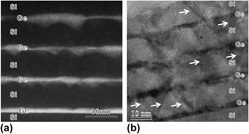Article contents
The microstructural and optical properties of Ge/Si heterostructures grown by low-temperature molecular beam epitaxy
Published online by Cambridge University Press: 17 May 2013
Abstract

Multilayer Si/Ge heterostructures with the thickness of Ge layers varying from 2 to 12 monolayers (MLs) were formed by molecular beam epitaxy on the (001) Si substrates at 300 °C (Ge) and 450 °C (Si). Using conventional and aberration corrected scanning transmission electron microscopy, x-ray reflectometry and x-ray standing waves, a thorough study of the Si/Ge heterostructures was performed. Optical properties of the heterostructures were probed by photoluminescence spectroscopy. It is shown that the growth of Ge layers up to a thickness of 5 ML occurs through the Frank–van der Merwe mechanism. For thicker Ge layers the growth mechanism of the Si–Ge heterostructure changes to Stranski–Krastanov with Si–Ge islands having the shape of inverted pyramids. We discuss the intermixing of Si and Ge due to stress induced interdiffusion. An explanation of the influence of the observed structural peculiarities on the PL spectra of the heterostructures is given.
- Type
- Articles
- Information
- Copyright
- Copyright © Materials Research Society 2013
References
REFERENCES
- 6
- Cited by




